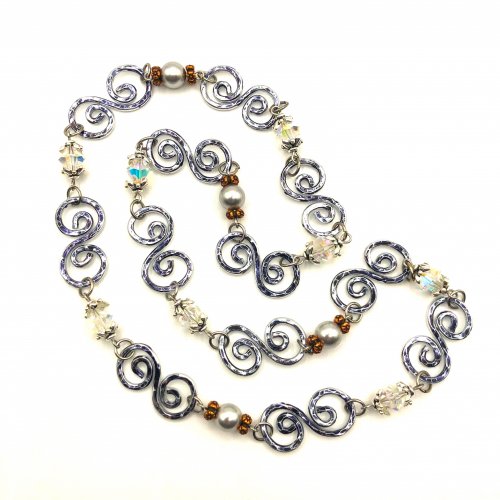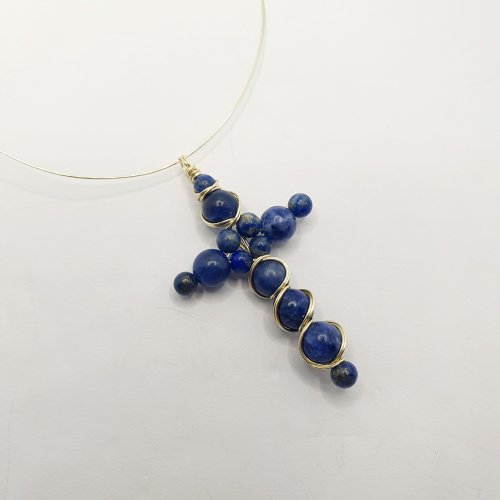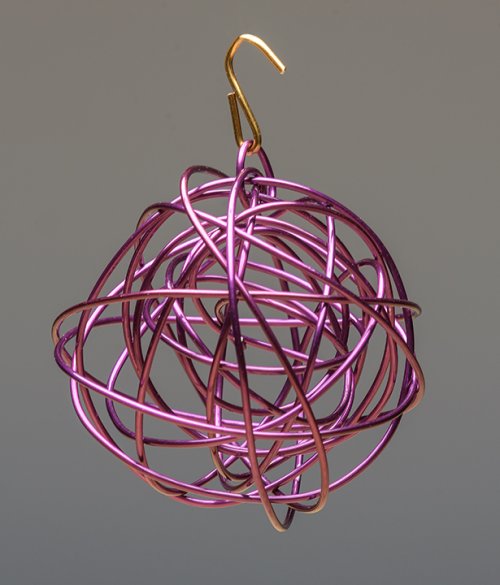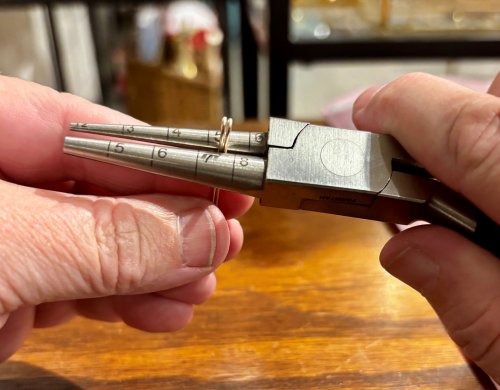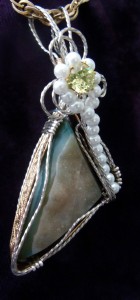Glossary of Jewelry Terms
You are excited about making jewelry, and to further your knowledge, you will need to become familiar with the different terminology associated with your new skills. Being able to communicate with your customer is important. Being able to converse comfortably and confidently can make all the difference in gaining or losing a potential customer.
Most of the terminology listed here pertains more to bench jewelers than to those who are learning and mastering wire artistry. However, don’t ignore them because expanding your knowledge is important. Learning those terms applicable to the creation of any piece of jewelry is crucial. This list by no means contains all the different terminology applicable to jewelry making, but it does represent a good balance of information to become familiar with.
Alloy: A mixture of two or more metallic metals to improve the overall strength and structure of the alloy. Gold in its pure state (24K) is too soft for any practical jewelry uses. By combining it with small amounts of harder metals, like copper, nickel, or silver, the blending creates a more durable and usable material.
Anneal: The process of heating work-hardened metal to restore malleability. A specific temperature is used for a set period of time (depending on the substance and the intended application), then slowly cooling it to toughen the substance and reduce the brittleness that develops while working it. Small pieces can be heated with a torch; larger items are generally annealed in either a kiln or an annealing oven.
Anodize: To produce a controlled oxidation of a metal's surface by means of a chemical (acid) bath through which the positive end or "anode" of an electrical current is passed. A thin protective film is created on the surface by the resultant change in the molecular structure of the top layer only. Anodization can give the metal a lustrous sheen or even change the coloring of the surface. This process is widely used for "coloring" titanium and niobium metal. Different voltage settings create different colors on the metals.
Aqua Regia: A mixture of three parts hydrochloric acid and one part nitric acid used to test the purity of gold and platinum. The mixture is one of the few chemicals that can dissolve these metals.
Assay: A test of purity for an alloy to determine the percentage of precious metal content.
Aurora Borealis (AB): Named for the northern lights, aurora borealis is a term for crystal stones that have a highly iridescent surface. This stone was created by Swarovski® in 1955 in collaboration with Christian Dior. The effect is achieved by vapor blasting the facets of the lower part of the crystals with an invisible, micro-thin metal sheet. This stone was created by Swarovski® in 1955 in collaboration with Christian Dior. Also known as AB, the term now refers to any highly iridescent surface.
Bail: A metal loop that is used to attach a chain or cord to a pendant.
Bakelite: Bakelite has had a renaissance in recent years. It is the trademarked name for synthetic resins and plastics developed by a US chemist. Jewelry pieces made of Bakelite, especially with animal and fruit motifs, were extremely popular in the US in the 1930s and are now considered collectors' items, though still a highly specialized category.
Baroque Pearl: An irregularly shaped pearl.
Base Metal: Any metal other than precious metals, such as lead, bismuth, tin, antimony, copper, etc. Alloys of non-precious metals are also referred to as base metals. Findings made of base metal (silver or gold colored) are the cheapest to buy and are great for practice for beginning wire workers and beaders. Perfecting your skills allows you to move up to using better findings and beads in your work.
Base metal findings are usually made of a nickel alloy material that can cause allergic reactions in some people, especially when used in body piercings. Those sensitive to nickel alloys should use only 14 K (or higher) gold found in quality gold-filled findings. Surgical-grade stainless steel findings are also available (usually referred to as hypoallergenic). Most nickel-sensitive people can also tolerate sterling silver without problems.
Bezel: A strip of wire that surrounds and secures a stone or other object. Bezels can be made or purchased in various standard calibrated sizes for cabochons. As a wire worker, you create your own bezel using half-hard square wire.
Biwa: A cultured pearl originally non-nucleated, grown in a freshwater mussel from Lake Biwa in Japan. Only those actually produced there should be called Biwas; others are simply called freshwater cultured pearls.
Briolette: A briolette is an elongated, pear-shaped stone covered with bands of triangular or rectangular facets, usually with a pointed end and without a girdle.
Bronze: An alloy containing at least 60% copper plus tin and sometimes other metals.
Brushed Finish: Created by the use of a stiff metal brush along the surface of metallic jewelry to add texture and to produce a slightly less reflective surface, creating a matte finish that has become highly popular in gold-filled, sterling, and silver beads.
Cameo: A carved gem, such as agate or shell, in which the carved design stands out against a background of a different color.
Casting: A process for making metal items that has been used for thousands of years. Molten metal is poured into a mold. There are different methods of casting, including centrifugal (or investment), sand casting, and the lost wax process.
Chain Mail or Chainmaille: This technique has seen a resurgence in popularity in recent years. Patterns available for modern chain mail are amazing in their complexity and beauty. Joining metal rings of predetermined sizes together can produce flexible metal "fabric" in a variety of items, such as necklaces, bracelets, and even shirts. Chain mail was used in medieval times for flexible armor and is now used to make striking jewelry.
Chalcedony: Various types of colored quartz, usually with a milky appearance, including carnelian, agate, cat's eye, and jasper.
Chasing: Using a hammer and steel tools to recess and/or reshape metal from the front. This technique is used to add texture to the surface of metal with hammers having a pattern engraved in the head and using on such items as washers, metal strips, etc.
Chromium: A hard, shiny, gray-white metal that resists corrosion quite well. Sometimes used in costume jewelry as a coating over other metals.
Cloisonné: Enamel with surface decorations set in hollows formed by strips of wire welded to a metal plate. Artisans of China are well known for their cloisonné creations.
Cubic Zirconia (CZ): A synthetic gemstone developed in 1977 to simulate a diamond. These days, "cz's" come in a wide range of colors and styles and can add enormous bling to your creations.
Drawplate: In metalsmithing, particularly wire jewelry applications, a drawplate is a die plate through which wire is pulled to reduce its diameter. A drawplate is used in Viking Knit and even crocheted wire jewelry to reduce and tighten the weave of the finished piece. Making your own drawplate is quite simple, using an inch-thick block of hardwood, and drilling a series of holes at least 1/4" apart, from 1.5mm to 10mm in diameter in .5 increments. By passing the length of finished woven wire through each drilled hole, you reduce the size of the woven wire to the size you want.
Ductile: A substance is "ductile" if it is easily pulled into a thin wire. The most ductile metal is gold, and it is the easiest wire to pull through a drawplate to reduce the diameter.
DWT: The abbreviation for Penny Weight in the Troy System of Weights.
Electroplate: (See Plating) Rings, ear hooks or wires, and crimp beads.
Embossing: The process of raising a domed design on the front of a piece of metal by beating it from behind with punches and a hammer.
Finding: Manufactured components used to create jewelry. Generally, findings provide the structure for the jewelry design; the ornamentation is provided by both the design of the finding as well as the gems, beads, or other decoration that is added. Findings include jump rings, clasps, bails, headpins, ear wires, and charms, to name a few.
Fineness: Usually expressed in parts per thousand, it is the proportion of silver or gold in a metal alloy. For example, Sterling Silver is .925, meaning that 925 parts per 1000 are silver, and 75/1000 is another metal. Fine Silver is 99.9% pure silver. Gold fineness is measured in Karats.
Foil: A thin leaf of metal placed behind a gem or paste stone to heighten its color or brilliance. Foil was added to the back of genuine gems in the 1800s to enhance the colors of faceted stones.
Gauge: The measurement of the thickness of an object, particularly wire and sheet metals. Wire gauges for jewelry applications will range from a very thick 4g to a very fine 34g. You must remember that the smaller the gauge, the larger the diameter of the wire.
German Silver: Also known as NICKEL SILVER, this alloy is actually roughly 60% copper, 20% nickel, and 20% zinc. If approximately 5% of tin is present in this alloy, it is called Alpaca. As you can see, there is no silver in German Silver. German silver wire is very inexpensive and is used to create costume jewelry. It should be noted that about 1 person in every 10 has a metal allergy to nickel.
Gold: Gold is one of the most visually attractive of all metals, and because of its unique composition, it is considered the "most precious" metal. It is one of the heaviest of all the metals, having resistance to tarnish or corrosion, and is very durable. One of the first metals to attract the attention of early man, gold’s durability has been attested to by the discovery of elaborately crafted artifacts of gold in nearly perfect condition from the ancient Egyptian, Etruscan, and Assyrian cultures.
Gold occurs in nature in almost pure form and is the most malleable and ductile of the metals. It is a good conductor of heat and electrical current, and in its pure state is very soft. One troy ounce of gold (the size of a sugar cube and equal to about 31 grams) can be hammered into a sheet (called gold leaf) covering 108 square feet or pulled into a thread fifty miles long. When you buy gold jewelry, it isn't pure gold. The purity or fineness of gold in the jewelry is designated by its karat number. 24-karat (24K or 24 Kt) gold is as pure as gold for jewelry gets. 24K gold is also called fine gold and it is greater than 99.7% pure gold. Proof gold is even finer, having a rating of over 99.95% purity, but it is only used for standardization purposes and is not available for jewelry.
Gold-filled (GF): A gold alloy plate made by soldering, brazing, welding, or other means that is not less than 10Kt fineness, where the plating constitutes at least 1/20th of the weight of the metal in the entire article. The term must be preceded by the karat fineness of the plating, such as 14Kt Gold-Filled. When using the term gold overlay, manufacturers are permitted to use a layer of gold that is less than 1/20th the weight of the entire piece, but they must stamp the proportion of the gold layer on the jewelry.
Harden: The process of manipulating malleable wire so that it will retain its shape and design and strengthen it so it will bear the weight of other components in a piece. The three most frequent methods of hardening jewelry wire are drawing, manipulating, and striking. Simply working soft wire back and forth with the hands will impart some hardness, as will working with nylon jaw pliers. Drawing refers to pulling wire through a smaller hole in a wood plate to reduce its diameter. To harden and flatten a shaped piece at the same time, the piece is put between two pieces of leather which are then placed between two jeweler's blocks. The blocks are then struck by a hammer. You can also use a leather mallet to strike the piece when it is laid on a protected surface that will not mar the metal.
Hardness: A measurement of the malleability or temper of a substance. When purchasing raw materials for wire-work, you will find that wire comes in several different levels of hardness, only a few of which are commonly used by jewelers.
In jewelry wire, hardness or malleability is graded soft or dead soft, quarter hard, half-hard, full hard, and spring hard. You may also encounter wire or sheet metal hardness that is designated numerically instead of by names. The numbering system, which goes from zero to 10 or more, is based on the number of times wire has been drawn through progressively smaller holes in a drawplate. Each jump in the number designates a doubling of the preceding number. Soft or dead soft has a number of zero, since it isn't drawn through a plate. Quarter hard is drawn through once, half-hard has been drawn twice and hard has been drawn through four times. Spring wire has been drawn eight times through successively smaller holes.
The best hardness to use for an application will depend on the intended use of the wire, as shown below:
- Dead Soft Wire is extremely malleable and can be bent easily into a myriad of shapes using the hands. It does not hold its shape in stress situations, such as clasps, until it is hardened. You would use dead soft if the application has several loops and swirls, which are more perfectly done with bare hands.
- Half-Hard Wire is malleable, but most people will need to use tools or jigs to bend it into shape. Half hard will, however, maintain a fairly intricate shape under moderate stress after it has been work hardened. It is very useful for lightweight bearing parts of wire-wrapped jewelry.
- Hard or Full Hard Wire holds its shape for wire-wrapping jewelry and for making clasps and other findings that will likely be stressed. Tools are recommended when bending or manipulating hard wire.
- The gauge (thickness) of the wire will also have an effect on its hardness. For example, a piece of 12 gauge wire is relatively thick, and even at dead soft hardness will not bend as easily as 18 gauge wire of the same hardness.
To test for the hardness of sheet metals, the Vickers Hardness test (designated HV) is very precise, calculating hardness from the size of the indentation a diamond-shaped pyramid produces under measured pressure. The Knoop Hardness test (HK) is based on the same principle as the Vickers test but is used on brittle materials such as glass and ceramics using lower pressures. The Mohs Scale of Hardness is a rating system for minerals based on their resistance to scratching by other minerals, on a scale of one to ten. Mohs used ten minerals to determine the degree of hardness, ranking the softest (Talc) as #1 and the hardest (diamond) #10.
Intaglio: Decoration made by carving or engraving a design into a gem or other hard material. Intaglio is the opposite of cameo.
Iron: This metal is very seldom used in jewelry because of its lack of luster and because it is so brittle.
Karat: The fineness of gold, equal to one part of 24 in gold alloys. (See Gold)
Karatclad: A trademark for a very thick gold electroplating process which is approximately 14 times thicker than standard electroplating.
Malleable: This term indicates that a metal or alloy is easily worked by hand or other tools.
Millefiori: Created by the fusion of several glass rods arranged so that the cross-section creates a flower or pattern with a mosaic-like appearance.
Memory Wire: A hardened steel wire that will retain its original shape even after repeated use. Available in a standard and "Cadmium" (silver-colored and rustproof) finish, and in diameters suitable for rings, bracelets, and chokers.
Milling: The process of cutting metal while it is spinning, usually on a lathe, with symmetrical shapes and patterns.
Mokume-Gane: A Japanese metalsmithing technique that results in a wood-like finish by alternating layers of thin, colored metals laminated together. Designs or patterns are then punched, filed away, or hammered into the laminate, producing unique and delicate patterns.
Nickel Silver: Not silver at all, except in color, for this alloy contains no silver but is mostly copper (about 60%), with approximately equal parts of nickel and zinc added. With the addition of a small percentage of tin, the alloy is then called Alpaca. This alloy was first used in the mid-1800s by the Germans as a silver substitute.
Niobium: A lightweight, tough, hypoallergenic refractory metal, usually anodized to produce vivid colors for costume jewelry. Mars easily and cannot be soldered. After manufacturing into the desired shape, such as earwires, headpins, eyepins, or jumprings, the naturally grey base metal niobium is then anodized to create six signature colors. Most people who are metal-sensitive can comfortably wear niobium.
Palladium: Palladium (puh-ley-dee-um) is a dense and lustrous, precious white-silver metal. Discovered in 1803 by William Wollaston, it is named after the renowned asteroid Pallas, which is named after Athena, the ancient Greek Goddess of Wisdom. A cousin of the platinum metal group, this rare metal is popular for fine metal jewelry, findings, and beads.
Rhodium: One white metal of the platinum family of precious metals. Rhodium is quite expensive and is often used to plate both precious and base metals, giving them a hard, platinum-like sheen.
Rose Gold: Rose gold is a gold and copper alloy used for special effects in making jewelry due to its reddish color. Rose gold is also known as pink gold and red gold.
Rouge: An abrasive compound used with a buffing wheel to polish metals. Rouge is graded by the size of the abrasive, from very coarse to very fine (even though none of the grit is as large as any fine sandpaper), and each of the grades in between have different uses. For cutting down a rough surface (or removing heavy oxidation), Brown Rouge (also called Red Rouge) is considered a semi-aggressive primary compound because it contains large grains of abrasive (even though they are so small they can only barely be felt when rubbing the compound between your fingers). Brown Rouge is used for the first step in the polishing process for unfinished metal. Some metalsmiths only use Brown/Red rouge. Green Rouge is finer yet, and is sometimes used for a second polishing. White rouge contains the very finest abrasive and is used for the final polishing to produce a very high shine.
Rolled Gold: A very thin sheet of gold is laminated to a lesser metal, such as brass, then heated under pressure to fuse them together. The fused metal is then rolled into a much thinner sheet and used to make jewelry or other objects and is marked RGP for Rolled Gold Plate. The term ‘rolled gold’ is most often used in European countries and Australia. Rolled gold jewelry wears well over time.
Rolling: In metallurgy, this is the most-used method of taking metal from a cast ingot to a sheet or bar, with sheet metal being the most common product. Rolling is done by using either a cold or hot method. The metal produced by the cold-rolled process will have a much smoother surface and be stronger.
Russian Gold Finish: A finishing technique for jewelry that produces a matte, antique look.
Ruthenium: Another of the platinum group of precious metals, it is usually abbreviated Ru or Ruth. Ruthenium in small amounts is added to platinum alloys to strengthen and harden them.
Satin Finish: This method of finishing metal produces a semi-gloss finish that is between a matte finish and a brilliant one. It is done by making minute, extremely shallow parallel lines on the surface of the metal, reducing its reflectivity.
Setting: The base or section of a piece of jewelry that holds the stone or gem. If a setting has metal behind the stone, it is referred to as a closed setting. Where there is no metal behind the stone, the setting is considered "open." There are many different styles and types of settings available to the jeweler.
Silver: A fine, naturally-occurring precious metal with an almost white sheen that is used for many purposes, including jewelry. Pure silver is usually alloyed with other metals, such as copper, for use in jewelry and hollowware. Silver tarnishes after exposure to air, forming a thin layer of silver-oxide on the surface. Silver often occurs near copper lodes.
Silver 800: Silver alloy which contains 800 parts per 1000 (80%) silver and 200 parts per thousand (20%) copper, and is used primarily for casting.
Solder: A metal alloy used to join other metals by applying heat that melts the solder but not the metals being soldered. Available in gold and silver as well as base metal, solder also comes in different grades and required temperatures. Not all solder melts at the same temperature, and it is crucial that solder be of a grade that melts at a lower temperature than the metals to be joined.
Steel: An alloy of iron and carbon where the content of the carbon ranges up to 2%. When the alloy contains more than 2% carbon, it's defined as cast iron. Steel is very seldom used for jewelry.
Sterling Silver: Silver with a fineness of 925 parts per 1000 (92.5%) silver and 75 parts per thousand (7.5%) copper, which increases the silver's hardness. Sterling is quite malleable and ductile.
Surgical or Surgical Stainless Steel: Any one of a family of low carbon alloy steels usually containing 10-30% chromium. The chromium provides exceptional resistance to corrosion and heat. Other elements may be added to increase corrosion resistance to specific environments, enhance oxidation resistance, and impart special characteristics. In jewelry, which is sometimes labeled "hypoallergenic," we see it in a few findings, such as ear wires or posts.
Temper: The temper of wire is often referred to in terms of hardness or softness. The temper or hardness of the wire indicates the malleability of the wire to hold its shape and to bend fluidly. It can range from dead soft (which bends with no resistance, sort of like a wet noodle) at one end of the spectrum to extra spring hard.
Torsade: A necklace made of several strands that have been twisted together.
Troy Weight: The system of units of mass customarily used for weighing precious metals and gemstones. Its name comes from the city of Troyes, in France, an important trading city in the Middle Ages. The system is based on the troy pound of 5760 grains. The pound was divided into 12 ounces (480 grains) each containing 20 pennyweights (24 grains).
Vermeil: Gold-plated silver; or occasionally, gold-plated bronze. Vermeil has a very rich gold color, usually darker than high-karat gold.
Weld: A process that joins two pieces of metal using very high heat. Rolled gold is formed in this method.
White Gold: Gold that has been alloyed with a mixture of copper, manganese, nickel, tin, and zinc, and sometimes palladium, giving it the look of platinum. White gold was originally developed during WWII to imitate platinum, which was at the time considered a strategic material for military applications.
Yellow Gold: An alloy of gold with a mixture containing 50/50 copper and silver.








